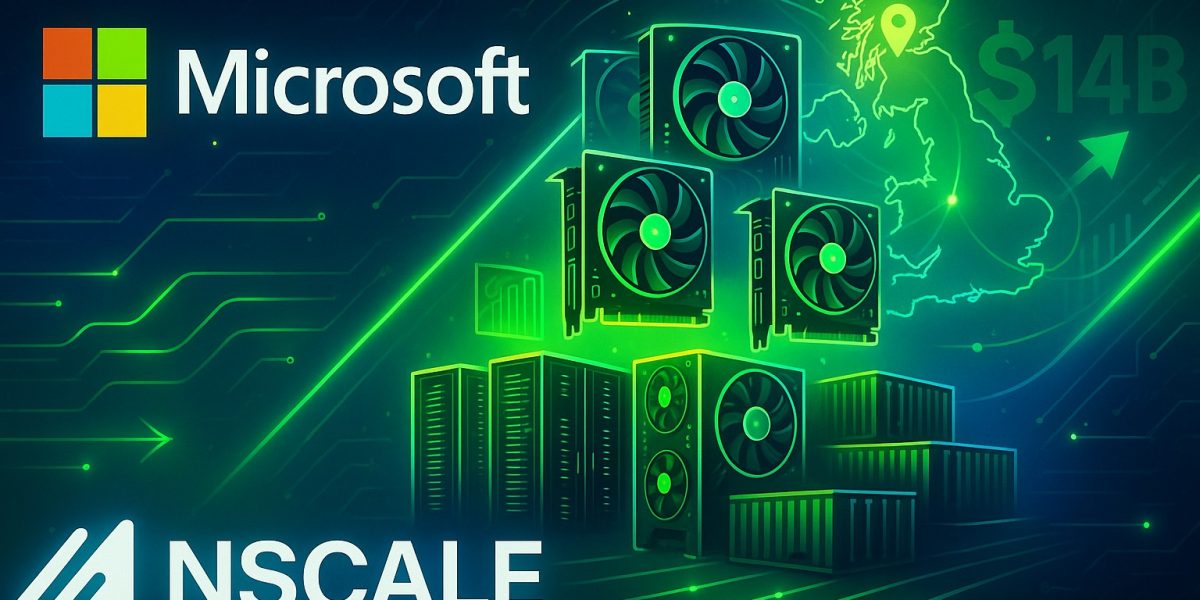British artificial intelligence company Nscale announced Wednesday that it has secured a deal potentially valued at up to $14 billion with Microsoft to deploy approximately 200,000 Nvidia AI processors across data centers in Europe and the United States. This agreement represents one of the largest AI infrastructure contracts ever signed, highlighting the accelerating global race to build the computing capacity needed for artificial intelligence applications.
Under the deal terms, Nscale will deliver roughly 104,000 Nvidia GB300 graphics processing units to a 240-megawatt AI campus in Texas, plus another 12,600 GPUs to a facility in Portugal, with deployment beginning in early 2026. The company will lease the Texas site from Ionic Digital in Barstow, with plans to eventually scale the facility to 1.2 gigawatts of power consumption. Microsoft holds an option to expand the Texas operations by an additional 700 megawatts starting in late 2027.
Understanding the Infrastructure Investment Wave
The Nscale agreement arrives amid unprecedented growth in AI infrastructure spending, which analysts estimate will reach $3 to $4 trillion by 2030. According to Citigroup data, hyperscale companies plan to spend $490 billion on infrastructure next year, up from an earlier projection of $420 billion. This spending surge has triggered what some observers are calling a construction boom unprecedented in recent history.
“This agreement validates Nscale’s position as the partner of choice for the world’s most important technology leaders,” stated Josh Payne, Nscale’s founder and CEO. “Few companies can execute GPU deployments at this scale, but we have the experience, and we’ve built the global infrastructure to do it.”
The deal builds on previous agreements between Nscale and Microsoft, including a joint venture with Norwegian company Aker that will supply Microsoft with approximately 52,000 Nvidia GPUs from a facility in Narvik, Norway. The companies are also developing what they describe as the UK’s largest AI supercomputer, equipped with 23,000 Nvidia GB300 graphics processors at Nscale’s planned facility in Loughton, Essex.

Examining the Deployment Scale and Logistics
The numbers involved in this deployment reveal the massive physical infrastructure required to support modern AI workloads. At 104,000 GPUs in the Texas facility alone, Nscale is building one of the world’s largest concentrated AI computing resources. Each Nvidia GB300 GPU requires substantial power, cooling, and networking infrastructure, creating complex logistical challenges beyond simply installing hardware.
The 240-megawatt initial capacity in Texas provides context for the energy requirements. For comparison, that’s enough electricity to power roughly 200,000 typical American homes continuously. The planned scaling to 1.2 gigawatts would quintuple that capacity, positioning the facility among the largest data centers globally by power consumption.
The Portugal deployment of 12,600 GPUs represents a more modest but still substantial installation. This geographic diversification gives Microsoft AI computing capacity across multiple regions, reducing latency for European users and providing redundancy if issues affect one location.
Microsoft’s option for an additional 700 megawatts in Texas starting late 2027 demonstrates the company’s expectation that AI computing demands will continue growing substantially. This expansion option essentially allows Microsoft to nearly triple the Texas facility’s capacity as their AI workloads scale.
From Bitcoin Mining to AI Infrastructure Giant
Nscale’s rapid ascent reflects broader transformation across the AI sector. The company spun out from bitcoin mining firm Arkon Energy just last year but quickly established itself as a major player in AI infrastructure. In September, Nscale raised $1.1 billion in funding from investors including Nvidia, Nokia, and Aker—what the company called the largest Series B round in European history.
This trajectory from cryptocurrency mining to AI infrastructure isn’t coincidental. Both industries require massive computing power, efficient cooling systems, and access to affordable electricity. The operational expertise and relationships Nscale developed in crypto mining translated directly to AI data center operations, enabling the rapid pivot.
The company now targets an initial public offering in 2026, with CEO Payne stating in a recent interview that “we have ambitions for going public.” The fast growth occurs as demand for AI computing power continues exceeding supply, creating opportunities for specialized infrastructure providers like Nscale to partner with technology giants seeking to expand their capabilities.
Market Context and Competitive Dynamics
Wednesday’s announcement coincided with another major AI infrastructure deal: a consortium including BlackRock, Nvidia, and Microsoft agreed to acquire Aligned Data Centers for $40 billion. The parallel deals underscore how companies across the technology ecosystem are competing to secure the physical infrastructure necessary to support the next generation of AI applications.
This competitive intensity stems from a fundamental supply-demand imbalance. The AI models powering applications like ChatGPT, Midjourney, and enterprise AI platforms require orders of magnitude more computing power than previous software generations. Training large language models or generating high-quality images involves trillions of calculations performed across thousands of GPUs working in parallel.
Nvidia’s dominance in AI-optimized GPUs gives the company tremendous leverage. The GB300 processors specified in the Nscale-Microsoft deal represent Nvidia’s latest generation architecture, offering performance improvements over previous GPU generations. However, the limited supply of these cutting-edge processors creates bottlenecks that constrain how quickly companies can expand AI capabilities.
Nscale’s ability to secure allocation for 200,000 Nvidia processors demonstrates strong relationships with both the chip manufacturer and power/facility providers. These relationships become competitive advantages as other companies struggle to access sufficient GPU supply.
Financial Structure and Risk Considerations
The deal’s potential $14 billion valuation warrants examination. This figure likely represents the total value over multiple years including hardware costs, facility construction, power supply agreements, and service margins. The actual revenue Nscale receives may be substantially lower, with much of the value flowing to hardware suppliers (primarily Nvidia), construction contractors, and utility providers.
The phased deployment starting in early 2026 with expansion options through late 2027 and beyond suggests this is a multi-year agreement rather than a single transaction. This structure spreads both the investment and the risk across an extended timeline.
For Nscale, the deal represents validation that enables their planned 2026 IPO but also creates substantial execution risk. Deploying 104,000 GPUs in Texas alone requires flawless coordination across construction, power infrastructure, networking, cooling systems, and GPU installation. Delays in any component could cascade through the timeline, potentially affecting Microsoft’s AI product roadmaps.
For Microsoft, the deal provides certainty about future AI computing capacity—critical for competing with Google, Amazon, and Meta in AI services. However, it also represents a massive capital commitment that must generate returns through AI products and services.
Regional Economic Impact
The Texas and Portugal facilities will create substantial regional economic activity. Data centers at this scale require construction workforces in the hundreds, permanent technical staff for operations, and significant ongoing contracts with local service providers.
The Texas location in Barstow positions the facility in an area with available land, existing power infrastructure, and relatively favorable regulatory environments for data center development. The 1.2-gigawatt target capacity will likely require new transmission lines and potentially dedicated power generation to support the facility’s electricity demands.
Portugal’s inclusion reflects European priorities around data sovereignty and latency requirements. European regulators increasingly require that data about EU citizens remain within EU borders. Having substantial AI computing capacity in Portugal helps Microsoft comply with these requirements while serving European customers with lower latency than US-based data centers provide.
Technology Architecture Considerations
The specification of Nvidia GB300 GPUs throughout these deployments reveals Microsoft’s architectural choices. The GB300 represents Nvidia’s Grace Hopper Superchip platform, combining GPU acceleration with ARM-based CPU cores in a unified package optimized for AI workloads.
This architecture particularly benefits large language model training and inference—exactly the workloads Microsoft needs for Copilot, Azure OpenAI Service, and other AI products. The integrated design reduces data transfer bottlenecks that occur when CPU and GPU use separate memory systems, accelerating AI model execution.
The scale of GPU deployment also suggests Microsoft is preparing for multi-model AI services rather than focusing solely on text-based large language models. Image generation, video synthesis, and multimodal AI applications all require substantial GPU resources. Having 200,000+ GPUs available provides Microsoft with flexibility to allocate resources across varied AI workloads as product priorities evolve.
Implications for Microsoft’s AI Strategy
This infrastructure investment demonstrates Microsoft’s commitment to competing aggressively in AI despite already significant partnerships with OpenAI. While Microsoft can access OpenAI’s models through their investment relationship, owning and controlling dedicated infrastructure provides strategic advantages.
Direct infrastructure ownership allows Microsoft to prioritize their own workloads, implement custom optimizations, and avoid competing with other OpenAI customers for computing resources during high-demand periods. It also enables Microsoft to develop proprietary AI models independently of OpenAI if strategic priorities diverge.
The scale of investment—potentially $14 billion for Nscale’s deployment alone, plus the Aligned Data Centers acquisition and other infrastructure spending—positions Microsoft to support massive AI service expansion. This becomes critical as AI features expand across Microsoft 365, Azure, Dynamics, and consumer products like Copilot.
Competitive Positioning Against Cloud Rivals
Amazon Web Services, Google Cloud, and Microsoft Azure are locked in intense competition for AI workload hosting. Companies building AI applications need vast computing resources, and the cloud provider offering the best performance, availability, and pricing wins these lucrative enterprise contracts.
Nscale’s Microsoft deal provides Azure with additional differentiation. Customers choosing where to deploy AI workloads consider GPU availability, performance, geographic distribution, and reliability. Microsoft can now promote its expanding AI infrastructure as a competitive advantage, potentially winning customers who might otherwise default to AWS or Google Cloud.
The geographic diversity—Texas, Portugal, Norway, UK—also matters for multinational enterprises with data residency requirements. Having AI computing capacity distributed globally allows Microsoft to serve customers regardless of where their data and users reside.

Environmental and Sustainability Considerations
The massive power requirements—1.2 gigawatts planned for Texas alone—raise important sustainability questions. At that scale, the facility will consume more electricity than many small cities, creating both cost and environmental implications.
Data center operators increasingly focus on renewable energy sources and efficient cooling systems to reduce environmental impact. The Portugal location may benefit from abundant renewable energy in the Iberian Peninsula, while Texas facilities could leverage solar power in that state’s sunny climate.
However, the sheer scale of power consumption means even highly efficient operations will have substantial carbon footprints unless powered entirely by renewable sources. Microsoft’s public commitments to carbon neutrality create pressure to ensure these facilities operate sustainably, but the physics of powering and cooling 200,000 high-performance GPUs present genuine challenges.
Nscale’s evolution from British AI startup to major infrastructure provider securing a potential $14 billion Microsoft deal illustrates the massive capital flows reshaping the technology landscape around artificial intelligence. The deployment of 200,000 Nvidia GPUs across multiple continents represents one of the largest concentrated computing projects in history.
For Microsoft, this investment provides the physical infrastructure necessary to compete effectively in AI services against deep-pocketed rivals. The multi-year deployment timeline and expansion options demonstrate long-term strategic thinking rather than short-term opportunism.
For Nscale, the deal validates their rapid transformation from bitcoin mining spinout to AI infrastructure specialist while creating execution challenges that will test the company ahead of their planned 2026 IPO. Success requires coordinating complex technical, logistical, and financial elements across multiple countries and partners.
The broader market implications extend beyond these two companies. The $14 billion Nscale deal and $40 billion Aligned Data Centers acquisition announced the same day signal that AI infrastructure has become a strategic priority commanding unprecedented capital deployment. This infrastructure boom will shape which companies can effectively deliver AI services at scale over the coming years.




Post a comment